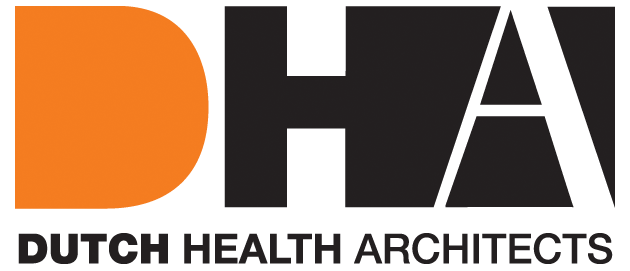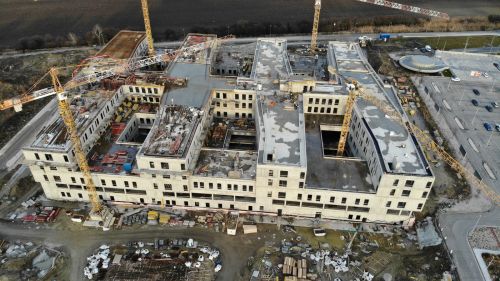Dutch Health Architects is chosen by hospital operator Svet Zdravia to design a modern facility for a hospital in Michalovce, Slovakia. Maurits Algra was interviewed in Trend Magazine regarding this new design.
The hospital in Michalovce is one of many Slovak hospitals that cannot boast a friendly environment. Old buildings with high maintenance requirements and another pavilion under long-term construction do not contribute to the provision of modern health care services. When the current operator, Svet zdravia, took over the hospital as part of a long-term lease from the self-governing region of Košice, it undertook to resolve the continuous construction. However, building a completely new hospital proved to be a better option than finishing the existing pavilion. The company belonging to the Penta investment group chose the Dutch Health Architects firm to design a modern facility. One of its architects, Maurits Algra, is convinced that the hospital environment itself can have a healing effect on patients and also fulfil the investor’s requirements for effectiveness at the same time.
Your company specialises in building hospitals. Why this segment, which is relatively complicated?
Our architectural firm was founded in the 1930s. After World War II, new infrastructure for hospitals needed to be developed. Our company specialised in this field and was growing. Relatively extensive know-how is required to design a hospital and this knowledge has to be developed, which takes time. Each new hospital is a step forward and should be approached innovatively.
They have changed significantly. We hold presentations at various conferences where we show Dutch hospitals built in the sixties. Hospital rooms were often in tall buildings, with outpatient departments in other buildings. At the time, people spent ten days or even two weeks in hospitals, even for simple surgeries. Today, the average hospital stay is four to five days. The function of the hospital has changed, with the number of beds gradually being reduced and hospital care no longer so focused on hospitalisation. The importance of outpatient and one-day health care began to grow. When this started, all these high buildings presented a problem. Since patients still need lifts, they are often crammed. Therefore, it was necessary to come up with a concept for a new type of hospital.
What do modern hospitals look like?
Their structure is more flexible. Buildings were constructed so that they could easily be expanded over time according to need. Large old buildings have numerous corridors and patients easily get lost in them. Hospitals should not be stressful for patients. The patient needs to access a doctor as simply as possible. We look for ways to make even very large buildings look compact and well-organised. We aim for flexibility, also in designing and dimensioning inpatient wards and departments. It is about creating an environment with a healing effect that is simultaneously highly functional and effective. It is important that hospital have considerable daylight for both patients and employees. A satisfied patient is the first step, although we also need to achieve a pleasant working environment for physicians and nurses. If a nurse is unhappy because she stresses about everything being so far away, patients will not be happy. The building should facilitate the quality of health care.
Are requirements for a healing environment compatible with investor requirements for high effectiveness and low cost?
Investors are interested in the building being adapted over time according to changes in his plans and health care demands. A healing environment forms the basis for well-functioning hospitals in which not only patients but also staff and visitors feel good. As a result, more people will choose that hospital, what is also very important for the investor.
You have worked on various projects around the world. How do client and patient requirements and needs differ?
The concept of a hospital in Germany cannot be used for a hospital in China. This would be very unfortunate. For instance, we designed a large oncological hospital in China. In China, it is customary for family members to take care of patients and this is beneficial. They help them with eating and wash their clothes. However, everything takes place in the room where other patients are also staying and this is not so good. Obviously, this should be changed but, at the same time, we cannot prohibit them from doing so. So we designed the hospital with rooms that could be used by the patients’ relatives for these types of activities. There is a kitchen and laundry room. We have placed these premises near the inpatient departments so that this facility is close, but not directly in the patient’s room.
How do you consider the type of care management for patients when designing a building?
We have met with many directors and managers of hospitals and we know how they work. We share this information with our other clients as well. For instance, there are various ways to get to an examination in specialist outpatient departments. Mostly you arrive and are told to sit down and wait, but do not know how long you will wait and simply wait until your name is called. Another way is to be told when to arrive and, if the physician is busy, you can walk around and receive a SMS when it’s your turn. This is different and very helpful way to communicate with patients.
Will this approach be reflected in the design for the hospital in Michalovce?
Yes. For instance, when waiting for treatment, people certainly do not like to have to sit in a hallway and stare at doors. The waiting area in Michalovce will be near an inner courtyard with seats in a pleasant setup. It should be possible for the patient to decide where he or she wants to sit.
There is a restaurant nearby, so when a patient knows approximately the time of treatment, he or she can wait there or walk around. We are planning a compact hospital with a nice atrium at the entrance and with inner gardens, which will provide sufficient daylight in each room and help patients with orientation.
Do you cooperate with physicians when designing?
Yes. We deal with the design of the hospital and physicians comment on proposals. We discuss the plans regularly.
It is difficult to explain your designs to clients? To what degree are you willing to compromise?
We are quite open and explain to clients why we have designed something a certain way and its advantage. Architects do not simply design according to the clients ideas, because then the client could design it himself. The challenge lies in finding what a client really wants and do it better than the client thought possible, to design it more effectively and more elaborately. Both architects and clients benefit from working together to produce something new and innovative that satisfies both parties.
Is the hospital planned for Michalovce comparable to any of your other projects?
We completed one project in the Netherlands that is comparable to the hospital in Michalovce in terms of size, but this structure will be more flexible. A wall is a light construction so that rooms can easily be made larger or smaller. The bed ward should be very innovative, without classic corridors. We try to transform them into functional premises designated, for instance, for patient families. They are close to the beds and patients have a view of the premises thanks to windows, which enable them to interact with the environment. If a patient wants privacy, he or she can draw the curtains. Large windows and glass doors are important for sufficient daylight.
Rooms with one, and no more than two beds, should be the standard in a hospital. According to hospital personnel, older patients in particular staying in hospital for a longer period do not want to be alone in the room. Do you consider this?
It is good to have a choice. It depends largely on the diagnosis. Approximately forty per cents of rooms in Michalovce will have one bed, while the others two. Three-bed rooms are also planned where appropriate for the patient, as in the children’s ward. One-bed rooms have the advantage that infections among patients spread less quickly.
The necessary investments for hospitals you have designed were significantly different, even though the number of beds was similar. Why?
Costs depend largely on the materials used and labour costs. Labour is very inexpensive in some countries, but fewer materials are available, so they need to be transported, upping the costs. Cost also depends on the technology used and air conditioning or heating in the hospital. There are many variations.
Is it possible to build high-quality hospitals with less money?
This was the greatest challenge for the hospital in China. In Europe, materials of comparable quality are available everywhere, but in China, Africa, or even Russia, the quality of materials is different, which is very demanding for an architect.
In which countries are investments in hospitals highest?
I think the most expensive hospitals are in the U.S., if we consider price per square meter. However, these hospitals are not always the best. Hospitals with the highest quality are Europe are for example in Switzerland, Germany, Denmark, the Netherlands or Spain. Hospitals in the U.S. mainly focus on the patient, but employees often work under artificial light. These are large buildings with working sections in the middle for employees and rooms for patients surrounding them. In Europe, we aim to combine effectiveness and a pleasant environment. A pleasant atmosphere is not about high costs; it is about colour and light and these things are not expensive.
How will you create a pleasant environment in the Michalovce hospital?
Contact with the park around the building, an inner garden, but also the materials used, including wooden details and natural stone. These are items that are not expensive, but help to create pleasant environment. But everything starts with sufficient daylight.
How long will it take to build the hospital?
Two years, which is a relatively short time. This requires good planning, but the project can be completed within this time limit.




